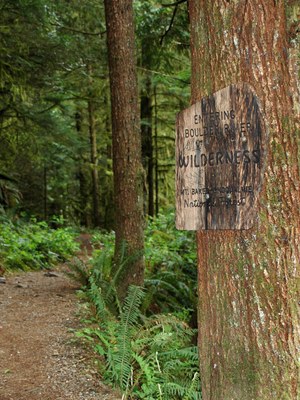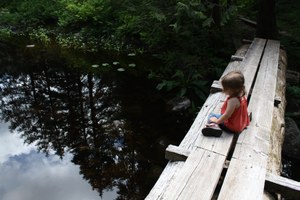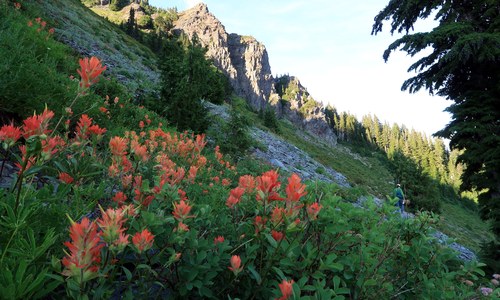 Washington Trails
Association
Washington Trails
Association
Trails for everyone, forever
What makes you feel like you're in the wilderness when you're out on trail? In partnership with WTA, researchers at the Pacific Northwest Research Station (the research arm of the US Forest Service) and the University of Washington used trip reports to try and answer that question. Some aspects of these wilderness experiences happen even on trails that are not in federally designated Wilderness areas. | by Anna Roth

There's a general assumption that "the wilderness” is just any forest, or even simply being outside. But Wilderness with a capital W refers to specially designated areas that are managed based on the 1964 Wilderness Act.
Wilderness areas have restrictions like no motorized use (including rules on what sorts of tools trail crews can use). They also usually have limits on the number of individuals per group in the area. The limit is typically 12 individuals, though some locations like the Enchantments cap it at eight.
These regulations are based on interpretations of the Wilderness Act itself, and are meant to preserve wilderness character and allow visitors to have certain types of experiences.
To determine measurable characteristics of wilderness experiences, researchers reviewed Forest Service guidance documents in addition to the Wilderness Act itself. These resources led the team to seven qualities typically associated with being in wilderness areas: aesthetics, awe, challenge, pristineness, quietness, solitude and timelessness — “allowing one to let go of day-to-day obligations, go at one’s own pace, and spend time reflecting.” (Landres et al., 2015, p. 51)". In evaluating trip reports, the researchers looked for observations that a trail had not changed over time.
It’s worth noting that the concept of pristineness (and to a lesser extent timelessness) in Wilderness management is rooted in a settler ideology that erases the impact Native people had, and still have, as they have been stewarding the land well before the Wilderness Act came into play.
Interestingly, these two characteristics were rarely referenced in trip reports, perhaps because of the slippery definition, or because they’re less tangible than the other five. Regardless, they were so infrequently referenced that the final analysis omitted these two.
 Heading toward the wilderness on the Olympic Peninsula. Photo from WTA archives.
Heading toward the wilderness on the Olympic Peninsula. Photo from WTA archives.Solitude was the only characteristic specifically named in the Wilderness Act. It appears in the passage: “...opportunities for solitude or a primitive and unconfined type of recreation.” Even so, it’s not mandatory for agencies to manage a wilderness area for solitude (note or in the phrase above).
Other characteristics, like aesthetics, awe and quietness, are described in agency guidance documents that help interpret the Wilderness Act. “We chose to study ‘quietness’ even though it was not explicitly named, since Landres et al. (2015) describe areas without the ‘sounds of modern human occupation’,” explained the researchers in the paper.
Once the researchers had determined which characteristics to study, WTA provided them with anonymized text from all the trip reports filed for trails on the Mt. Baker-Snoqualmie National Forest in the last 30 years (approximately 70,000 in all!). The researchers read nearly 1,100 of these trip reports to analyze the language hikers used to describe their experiences on these trails and manually code whether or not the hikers had described each of the wilderness-related experiences.
They then used these 1,100 trip reports to train a machine learning model (using Natural Language Processing, or NLP) and applied the model to the remaining 69,000 trip reports in the Mt. Baker-Snoqualmie National Forest to learn which trip reports described each experience. Finally, they used statistical models to understand relationships between the experiences described in trip reports, and the characteristics of the trails where they were reported.

Visitors reported wilderness characteristics often on trails that offered summits accessed by steep trails. Photo courtesy Sama Winder.
They found that visitors mentioned experiencing awe, aesthetic beauty, challenge and solitude relatively often, and that many aspects of the setting were important to whether wilderness qualities were described in a trip report. That means things like how long a trail is, how far it is from a city, whether it actually enters a Wilderness area, and whether hikers could see waterfalls, rivers or reach the peak of a mountain all contributed to whether someone reported experiencing wilderness qualities on a trail.
WTA’s online database of trip reports goes back 30 years. It’s a rich resource, but for many of those early years, the people writing trip reports were the first folks who could afford a home computer and who had the time to file a trip report. They were also writing reports for a much smaller number of hikes on our website. Not all of the Mt. Baker-Snoqualmie National Forest trails have been on our site for the full 30 years, so newer additions would be under-reported relative to the trails that have been on our site for longer.
As WTA grew, we added more trails to our Hiking Guide, and we also worked to welcome a greater diversity of people to our community. We’ve broadened the definition of what it means to be a hiker and worked hard to introduce more people to hiking.



Photos courtesy Sama Winter (right), and WTA archives (left and center).
With more diverse hikers comes a broader definition of what a hike is. For example, some people may consider just a few minutes alone on a trail enough times to report feeling solitude. Others may seek a whole day (or multiple days) without seeing another person. This can also affect how a trip report frames wilderness characteristics.
The hiking community in Washington is more diverse now, but we know it still skews Whiter and more male than Washington’s overall population. And while studies have been done examining visitation on the Mt. Baker-Snoqualmie, WTA doesn’t track trip reporter demographics, so there’s no way to say how representative our trip reporting community is of Washington’s hiking population.
National forests must consider all users as they manage their lands. In some cases, the law requires them to promote certain experiences, and land managers often rely on frameworks that assume certain settings will lead visitors to have certain experiences.
Currently, land managers restrict motorized vehicles, limit the number of campsites and signs, and only build simple, narrow trails in federally designated Wilderness. They expect the minimal development will allow visitors to have more challenging, awe-inspiring outdoor experiences — those typically associated with wilderness.

But as the study found, the question of what leads to a visitor having a particular type of experience is complicated. While wilderness designation was positively related to the hiking experience on trail, other aspects of the area can have a strong influence on a hiker's experience as well.
There are more questions to answer in the wake of the study, too.
Does a person consistently report the same wilderness qualities for the same trail on different days? Or does their experience vary with the season, the trail conditions, day of the week or even hour of the day? Is a particular trail more likely to be reported as having wilderness characteristics in a specific season?

Despite the further questions to answer, land managers can leverage the study’s findings for planning. For example, building or repairing a trail not in wilderness that accesses a waterfall or peak may provide more users with some of the benefits of a Wilderness trail, since the study found that some of the wilderness experiences are more common on trails with these characteristics.
These non-wilderness trails may be easier for mountain bikers and wheelchair users to access. The findings also suggest that experiences are related to more than just the setting of their hike, and that recognizing this would lead to management frameworks that better represent the complex web of personal experiences, social interactions, and senses of place which lead visitors to have particular experiences on public lands.
Want to know more? Contact Sama, Monika or Anna with questions. Sama Winder: sgwinder@uw.edu, Monika Derrien: monika.derrien@usda.gov, Anna Roth: anna@wta.org